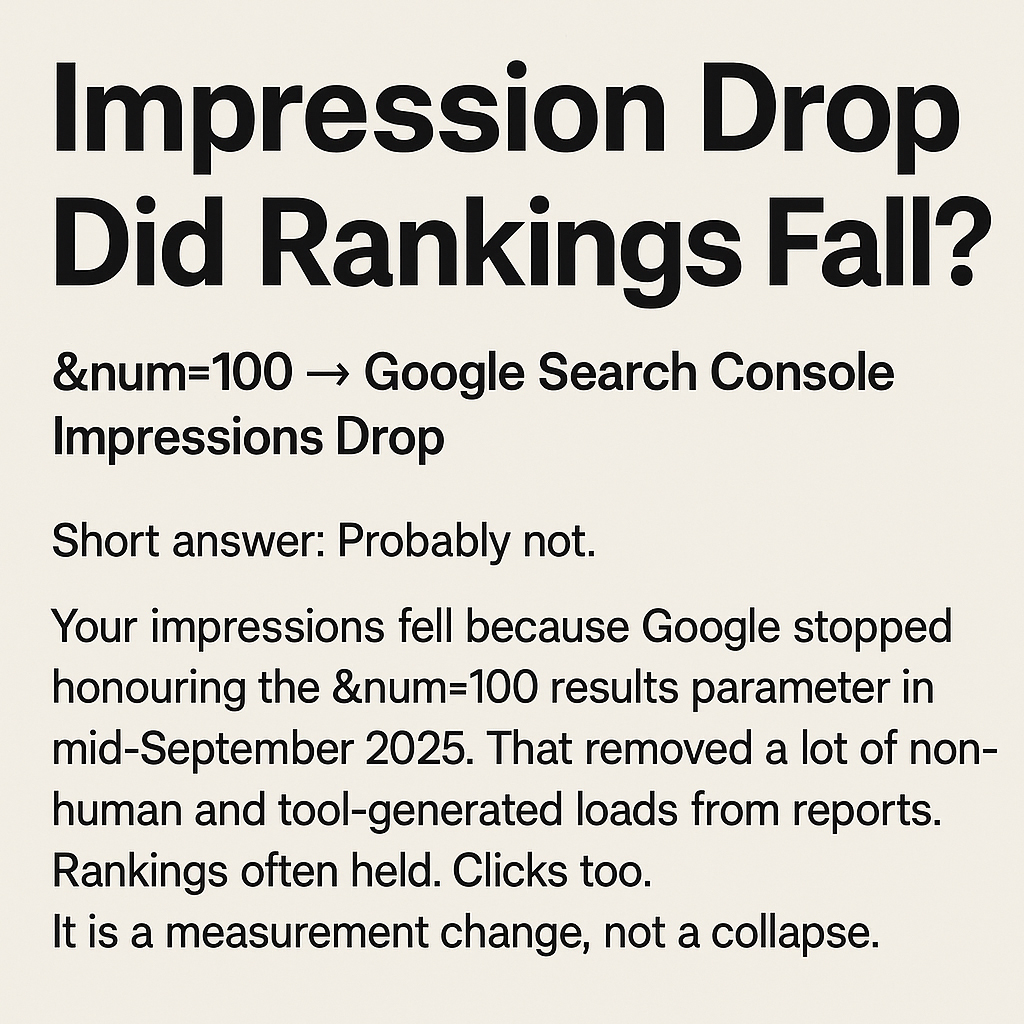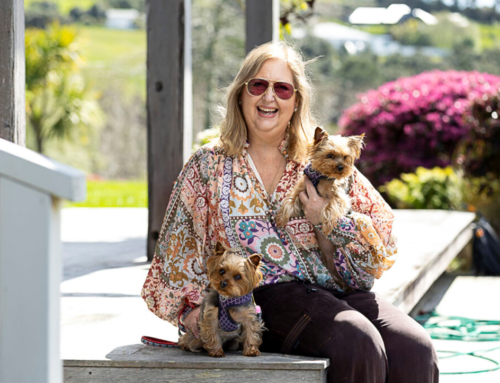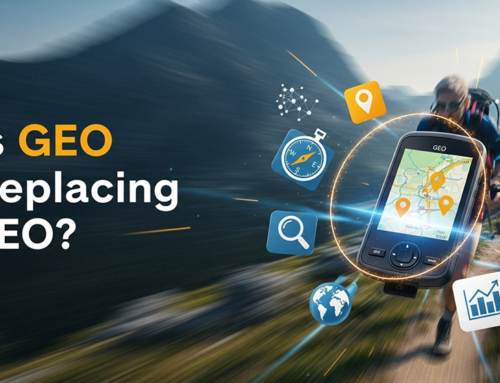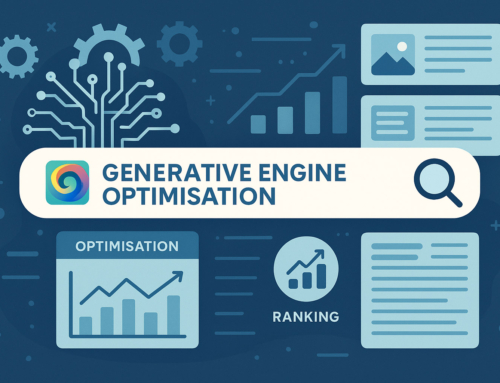
andnum=100 → Google Search Console impressions drop
Short answer. Probably not.
Your impressions fell because Google stopped honouring the andnum=100 results parameter in mid-September 2025. That removed a lot of non-human and tool-generated loads from reports. Rankings are often held. Clicks too. It is a measurement change, not a collapse. (Search Engine Land)
An impression only counts when the page that contains your result actually loads. With classic pagination back, that rule bites again. If users never reach the page your listing sits on, no impression is logged. (Google Help)
What changed in September 2025
andnum=100 removed
Your chart dipped. Your leads did not. That is the clue.
Google stopped supporting andnum=100 around 10 to 14 September 2025. Many rank trackers and scrapers relied on it to fetch one hundred results in a single request. When it vanished, those automated loads disappeared from your data. Impressions stepped down. The average position often looked better. Clicks usually stayed the same because people still clicked. (Search Engine Land)
What to tell your team
- This is a measurement change
- It removed many non-human impressions
- Treat mid September as a reporting break
Pagination replaced continuous scroll
Google ended continuous scroll in 2024 and returned to classic page numbers. Impressions only count on pages a user actually loads. If a user never goes to page two, your page two listing gets no impression. That small rule sets the stage for the step down you saw in 2025. (Search Engine Land)

What does an impression mean today
When an impression is counted
Google counts an impression when the page that contains your result is loaded. The user does not need to scroll to your exact listing. They do need to reach that page number. If your listing sits on page three and the user only views page one, no impression is recorded. Simple. Testable. Shareable. (Google Help)
Keep in mind
- Page must load
- Result can be above or below the fold
- No page load, no impression
Why average position and CTR moved
Average position is tied to impressions. When deep page impressions disappear, the maths changes. Your average position can look better without any real ranking lift. CTR can move as the mix of impressions changes. This is normal after the change. (Search Engine Land)
What to do
- Focus on clicks and enquiries first
- Track average position for top twenty queries only
- Annotate the break in every chart that includes impressions
Deep SERP pages and the long tail
The long tail often lives on pages two and beyond. With pagination back, impressions only fire when users click into those pages. Many do not. That means fewer long tail impressions. Your head terms on page one are less affected. The overall chart can look scary while money terms keep working. (Search Engine Land)
Practical moves
- Group reports by top one to twenty and twenty-one to one hundred
- Keep long tail content, judge it by clicks and leads
- Add internal links to lift near-miss terms into page one
Did rankings really fall
Quick checks on clicks and enquiries
Start with reality. Did people still contact you? If clicks and enquiries are steady, your rankings probably held. Use a simple before and after table for the twenty-eight days either side of 14 September. (Search Engine Land)
Check three things
- Total clicks in Search Console
- Enquiries or calls in Analytics or your CRM
- Branded clicks versus non-branded clicks
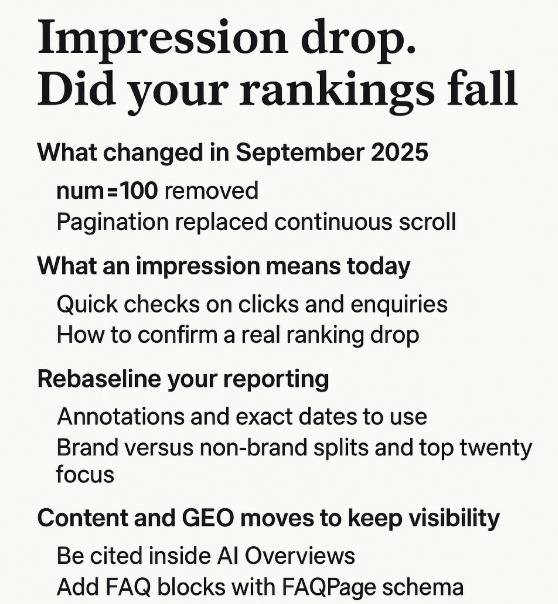
How to confirm a real ranking drop
Sometimes rankings do fall. Prove it fast or clear it fast.
Steps
- Compare average position for your top ten revenue terms across two twenty-eight-day windows
- Check landing page clicks for those terms for the same windows
- Run manual spot checks in a clean browser to confirm direction
- If both position and clicks fall, investigate content quality, links and SERP changes
Desktop versus mobile differences
Desktop and mobile do not behave the same. Pagination and query habits differ. Some sites felt the change more on desktop where long tail research is common. Mobile users often refine queries rather than paging.
Watch
- Device split in Search Console
- Query mix by device
- Device-level CTR and clicks
Content and GEO moves to keep visibility
Be cited inside AI Overviews
Getting named inside AI answers is a growth lever. Aim to be the concise source that models quote. Place short, sourceable definitions and Q & A blocks that machines can lift. Use Organisation and WebPage schema. Keep language clear and literal.
Try this
- One paragraph definition near the top
- One proof line with a trusted source
- FAQ block with three literal questions and short answers
- Two internal links to deeper help
Add FAQ blocks with the FAQPage schema
Q & A blocks improve scannability and help machines map your page. Keep the questions literal. Keep the answers short. Add FAQPage schema. Link related service pages from answers where helpful. Then watch if AI Overviews begin citing you. Iterate from there. (Google Help)
Short definitions, proof, and internal links
Models like short, unambiguous statements with a clear subject. People do as well. Start key pages with a crisp statement. Follow with a proof line and a link to a source. Then add two internal links.
Template
- What the term means in one sentence
- Why it matters in one sentence
- A source link
- Two internal links
Regional examples and use cases
New Zealand sample
We work in Auckland, Christchurch, Wellington, Hamilton, Tauranga, Dunedin, Lower Hutt, Palmerston North, Napier, and Hastings. We also serve Paihia, Coromandel, Nelson, Rangiora and Gore. The pattern has been consistent. Impressions stepped down after mid-September. Clicks and enquiries were steady. Average position nudged better on many accounts. Long tail impressions fell the most. Head terms on page one barely moved. This gives local teams confidence and stops needless churn on good pages.
International sample
Clients in South Africa, the UK, USA, Australia, Europe and Asia saw the same shape. Impressions down. Clicks steady. No sudden loss in high intent rankings. Tool dashboards looked messy for a while. First-party data stayed stable. Perhaps that is the best proof.
What stayed stable across regions
Three constants held across markets.
- Search Console clicks and CRM enquiries
- Top twenty query set
- Brand share of clicks
Hold to these, and your reports will stay believable even when charts move about.
FAQs
Did our rankings fall
Usually no. Most sites saw a measurement change after and Num=100 was removed. Add an annotation for mid-September 2025 and compare on clicks and enquiries. (Search Engine Land)
When did this happen
Around 10 to 14 September 2025. Add a visible note in Search Console and Looker Studio. (Search Engine Land)
Why did impressions fall but clicks did not
Automated loads dropped out when and Num=100 went away. People still clicked. Average position shifted with the new denominator. (Search Engine Land)
Does pagination matter
Yes. Impressions count only on pages a user loads. Page two and beyond now get fewer impressions. (Search Engine Land)
What should we change in reports
Add the annotation. Split brand and non brand. Focus on clicks, enquiries and your top twenty. Keep a rolling twenty eight day comparison set for the next quarter. (Search Engine Land)
How does this affect AI Overviews and GEO
Impressions shift into modules. You want your brand cited inside those summaries, not only listed. Use short definitions, Q and A blocks, and FAQPage schema. Add Organization and WebPage schema to strengthen entity signals. (Google Help)
How long will data feel noisy
Give it a month or two. By then your baseline will stabilise and your reports will feel normal again.
Need help right now
If you need to assess your online presence, we can run a fast reality check.
If you want to enhance your appearance in AI Overviews and AI Search, we will add a GEO layer to your key pages.
We have worked on GEO and SEO longer than most in New Zealand.
A stable agency supporting local and international business.
Net Branding. Be seen, Be heard, Be found Online.
Be seen, be heard, be found online.
Net Branding Limited
165 Orakei Road, Remuera, Auckland 1050, New Zealand
Phone: 09 523 0478
Website: netbranding.co.nz
Cathy Mellett
Founder and Director, Net Branding Limited
Since 2008, we have helped businesses across New Zealand and overseas.
Based in Auckland. Serving clients in Christchurch, Wellington, Hamilton, Tauranga, Dunedin, Lower Hutt, Palmerston North, Napier, Hastings. Also Paihia, Coromandel, Nelson, Rangiora and Gore. International work across South Africa, the United Kingdom, the United States, Australia, Europe and Asia.
LinkedIn. Contact 09 523 0478.

